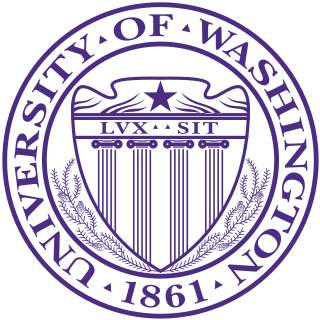
The University of Washington is a public research university in Seattle, Washington. Founded in 1861, approximately a decade after the founding of Seattle, the University of Washington is one of the oldest universities on the West Coast.

The University of Scranton is a private Jesuit university in Scranton, Pennsylvania. It was founded in 1888 by William O'Hara, the first Bishop of Scranton, as St. Thomas College. In 1938, the college was elevated to university status and took the name The University of Scranton. The institution was operated by the Diocese of Scranton from its founding until 1897. While the Diocese of Scranton retained ownership of the university, it was administered by the Lasallian Christian Brothers from 1888 to 1942. In 1942, the Society of Jesus took ownership and control of the university. During the 1960s, the university became an independent institution under a lay board of trustees.

William Henry Gates II, better known as Bill Gates Sr., was an American attorney, philanthropist, and civic leader. He was the founder of the law firm Shidler McBroom & Gates, and also served as president of both the Seattle King County and Washington State Bar associations. He was the father of Bill Gates, co-founder of Microsoft.
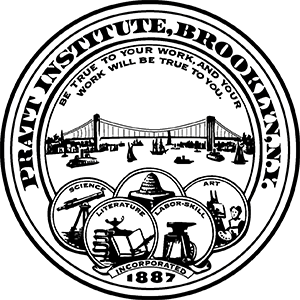
Pratt Institute is a private university with its main campus in Brooklyn, New York. It has a satellite campus in Manhattan and an extension campus in Utica, New York at the Munson-Williams-Proctor Arts Institute. The school was founded in 1887 with programs primarily in engineering, architecture, and fine arts. Comprising six schools, the institute is primarily known for its programs in architecture, graphic design, interior design, and industrial design.

The University of Washington Tacoma is a public university in Tacoma, Washington. It is a university in the University of Washington system. The UW Tacoma campus opened its first classrooms in repurposed warehouses in downtown Tacoma in 1990 and opened its permanent campus in 1997.

Mary Ann Gates was an American banker, civic activist, non-profit executive, and schoolteacher. She was the first female president of King County's United Way, the first woman to chair the national United Way’s executive committee where she served most notably with IBM's CEO, John Opel, and the first woman on the First Interstate Bank of Washington's board of directors.
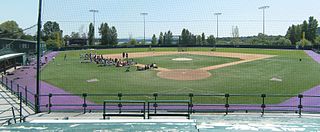
Husky Ballpark is a college baseball park in the northwest United States, located on the campus of the University of Washington in Seattle, Washington. Opened 25 years ago in 1998, it is the home field of the Washington Huskies of the Pac-12 conference. The playing field was renamed for donor Herb Chaffey in May 2009.

The University of Washington School of Law is the law school of the University of Washington, located on the northwest corner of the main campus in Seattle, Washington. The school is fully accredited by the American Bar Association and has been a member of the Association of American Law Schools since 1909.

The Danforth Campus is the main campus at Washington University in St. Louis. Formerly known as the Hilltop Campus, it was officially dedicated as the Danforth Campus on September 17, 2006, in honor of William H. Danforth, the 13th chancellor of the university, the Danforth family and the Danforth Foundation. Distinguished by its collegiate gothic architecture, the 169-acre (0.68 km2) campus lies at the western boundary of Forest Park, partially in the City of St. Louis. Most of the campus is in a small enclave of unincorporated St. Louis County, while all the campus area south of Forsyth Boulevard is in suburban Clayton. Immediately to the north across Forest Park Parkway is University City.

The campus of the University of Oregon is located in Eugene, Oregon and includes some 80 buildings and facilities, including athletics facilities such as Hayward Field, which was the site of the 2008 Olympic Track and Field Trials, and McArthur Court, and off-campus sites such as nearby Autzen Stadium and the Riverfront Research Park. An online guide to the university's built environment, Architecture of the University of Oregon, published by the University of Oregon Libraries, describes campus buildings and provides timelines of key architectural events linked with campus history.

The Information School at the University of Washington is an undergraduate and graduate school that offers BS, MLIS, MS, MA, and PhD degrees. Formerly the Graduate School of Library and Information Sciences (GSLIS), the Information School changed its focus and name in the late 1990s.

Benson Hall is a building in the University of Washington campus. It is home to the chemical engineering department. The building was named after Henry K. Benson, a faculty member from 1904 to 1954. During this time, he held the position of Chair of Chemistry and Chemical Engineering. Leonard William Bindon and John LeBaron Wright designed Benson Hall.

Housing at Georgetown University consists of 13 residence halls at the main campus and a law center campus. Housing on Georgetown's main campus is divided between "halls," usually more traditional dormitories, and "villages", usually less traditional apartment complexes. In addition, Georgetown operates many townhouses in the Georgetown neighborhood, usually for second, third, and fourth-year students.
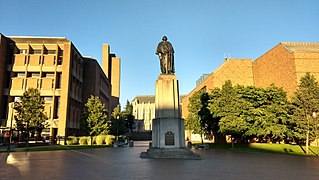
The Campus of the University of Washington is located in the University District of Seattle. Campus buildings are categorized by the major street or vicinity on which they are located on campus. In 2011, Slate magazine and Travel+Leisure described the Seattle campus as one of the most beautiful university campuses in the United States.
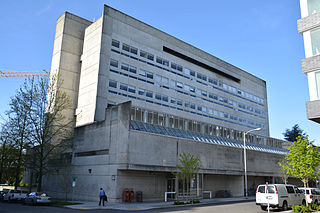
John T. Condon Hall is an academic building of the University of Washington in Seattle, Washington. The building formerly housed the UW School of Law. The hall was named after John T. Condon, the first dean of the School of Law.

Herbert Henry Gowen (1864–1960) was an Anglican missionary and orientalist who wrote on the history of China and Japan and was long associated with the University of Washington.

The Sylvan Grove Theater and Columns, also known as the Sylvan Grove Theater or simply the Sylvan Theater, is a sylvan theater located on the University of Washington campus in Seattle, Washington. Within the theater are four 24 foot (7.3 m) tall Ionic columns from the original University building downtown, constructed in 1861. They are some of the oldest-standing architectural pieces in Seattle. It has been called "one of the most beautiful places on campus."
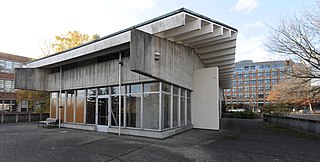
The More Hall Annex, formerly the Nuclear Reactor Building, was a building on the campus of the University of Washington (UW) in Seattle, Washington, United States, that once housed a functional nuclear research reactor. It was inaugurated in 1961 and shut down in 1988, operating at a peak of 100 kilowatts thermal (kWt), and was officially decommissioned in 2007.
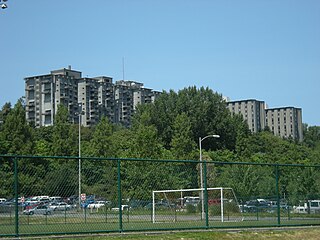
Housing at the University of Washington is administered by the Housing & Food Services (HFS) department at the University of Washington. Undergraduates are housed primarily in residence halls located on North Campus and West Campus. Typically, residence halls are 9-month spaces for undergraduate students. However, there are also 12-month apartment spaces available for undergraduate students. Graduate and professional students are provided the option to live in 12-month apartments operated either by the university or privately. The University of Washington does not require students to live on campus. Although students are not required, about 71% of freshmen choose to live on campus. Housing is not guaranteed but placement in the residence halls is guaranteed for returning residents. Most winter quarter and spring quarter applicants are assigned housing. There are also three family housing options for registered full-time students at the Seattle campus.

Gerberding Hall is a building in the northwest United States, located on the campus of the University of Washington in Seattle.





















